The Cambridge Girls: Martha, Marjorie, Minerva
by
Mark A. Nye
Issue No. 127 - November 1983
This month, a trio of Cambridge Girls, the "3Ms" are being featured. Two members of this trio were "born" during the Near Cut era, and the third (somewhat of a youngster), arrived in the mid 1930s.
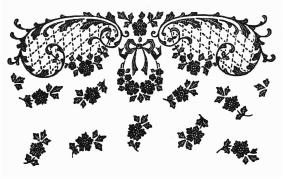
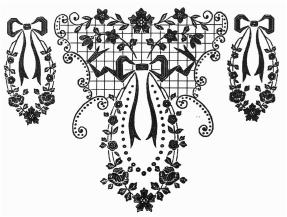 Minerva (shown at left), the youngest of the "3Ms" first appeared in the NCC 1930-34
Cambridge Catalog reprint on page 33-1, thus dating its introduction to
the beginning of 1933. The Welkers, in their Book II of Catalog
Reprints, show a page from a Cambridge advertising folder that
illustrates Minerva along with five other etchings, including
Rosepoint. Based on the appearance of Rosepoint, the earliest date we
can apply to this folder is 1935. (Rosepoint was introduced in 1935.)
Minerva does not appear in the 1940 or later Cambridge Glass Company
catalogs and price lists. However there is company research in
existence that proves Minerva, as well as its companion etching
Valencia (shown at right), was still very much available as late as September 1939.
Minerva (shown at left), the youngest of the "3Ms" first appeared in the NCC 1930-34
Cambridge Catalog reprint on page 33-1, thus dating its introduction to
the beginning of 1933. The Welkers, in their Book II of Catalog
Reprints, show a page from a Cambridge advertising folder that
illustrates Minerva along with five other etchings, including
Rosepoint. Based on the appearance of Rosepoint, the earliest date we
can apply to this folder is 1935. (Rosepoint was introduced in 1935.)
Minerva does not appear in the 1940 or later Cambridge Glass Company
catalogs and price lists. However there is company research in
existence that proves Minerva, as well as its companion etching
Valencia (shown at right), was still very much available as late as September 1939.
 Three stemware lines are known to have been etched Minerva, and it
is possible that there were others. The known lines are #3124,
#1402/100 Tally-Ho blown stemware and #3500 Gadroon.
Three stemware lines are known to have been etched Minerva, and it
is possible that there were others. The known lines are #3124,
#1402/100 Tally-Ho blown stemware and #3500 Gadroon.
Use of this etching was not limited to stemware. Unfortunately, very few pieces showing the Minerva etching are illustrated in the NCC 1930-34 Catalog Reprint. Gadroon and Tally-Ho sandwich plates are shown, as is the Tally-Ho three-piece buffet or Sunday evening supper set. Also pictured are Tally-Ho and Gadroon stemware items. Company research has been found that proves Minerva, as well as Valencia, was used extensively on three lines: #3400, #3500 Gadroon and Tally-Ho.
A complete dinnerware service using the #3400 line blanks was produced, including both the round and square plates. In addition, many serving and accessory pieces were also etched Minerva. As a matter of fact, many of the #3400 line items described in my previous article on "Diane" are to be found etched Minerva. There are, for example, four different sets of salt and pepper shakers, oil bottles, five pitchers, including the #3400/152 Doulton jug and decanters sets…all etched Minerva.
There is no lack of #3500 Gadroon line etched Minerva, except for a dinner plate. Cups and saucers, cream soups and saucers, fruit and cereal bowls, sugars and creamers, bowls, trays, relishes (17 or these, as a matter of fact), covered candy boxes, covered urns, ash trays and mayonnaise sets, are all listed as being etched Minerva. Last, but not east, is the Minerva etched #3500/25 9" Rams Head bowl, and the #3500/119 13" Tom and Jerry bowl.
Minerva on Tally-Ho blanks include: bread and butter plates, two sizes of salad plates, 9 ½" dinner plate, 10 ½" service plate and twin salad dressing bowls. Sets incorporating these bowls: cheese and cracker sets and nine bowls, relishes and comports were also done. Rounding out the Tally-Ho line with the Minerva etching were six flat tumblers, ranging in size from 2 ½ oz. to 15 oz.; the #1402/78 6 oz. punch mug; and to go with the mug, the #1402/77 13" footed punch bowl.
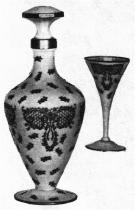 All of the preceding utilize crystal blanks. I was unable to find
any reference to Minerva on colored blanks, nor have I seen any. I have
seen a vase in forest green etched Valencia, and it is possible that
similar pieces were also produced with the Minerva etch. It is doubtful
that dinnerware was made on colored blanks.
All of the preceding utilize crystal blanks. I was unable to find
any reference to Minerva on colored blanks, nor have I seen any. I have
seen a vase in forest green etched Valencia, and it is possible that
similar pieces were also produced with the Minerva etch. It is doubtful
that dinnerware was made on colored blanks.
In the NCC 1930-34 Catalog reprint we find pages dating to 1934 which illustrate decoration D/1015, gold encrusted Minerva on Crown Tuscan. Shown on that page are: #3500/64 three compartment, two handled relish, #3500/12 12" handled and footed oval bowl, #3121 28 oz. footed decanter and the #7966 2 oz. sherry (the latter two are illustrated at left).
The #3500/21 bowl, with the gold encrusted Minerva on the interior surfaces also has an exterior gold encrusted pattern. This same decoration is to be seen on other Crown Tuscan pieces, again as a secondary design.
Gold encrusted Minerva is also found on crystal blanks. Unfortunately there are no price lists or catalog listings available from this era to provide an exact listing of blanks decorated in this manner. Serving and accessory pieces, as well as salad plates have been seen by this writer and it is entirely possible that cups, saucers and stemware items were done. A recently seen piece was the #3500/41 10" Urn or Candy Jar in crystal with the gold encrusted Minerva etching.
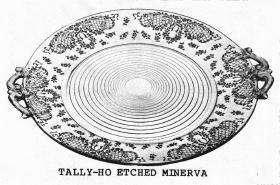
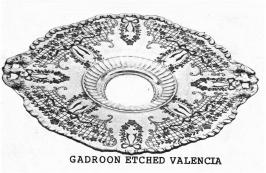 Minerva and Valencia are somewhat similar in design and confusion
may arise when trying to distinguish between the two without the aid of
a catalog reprint. (Webmaster's Note: Refer to the two plates shown
here at left and right.) I have found a way to
quickly answer the question
"which is it?" All of the lines in Valencia meet at right angles and
run vertical and horizontal, while the lines in Minerva are on a slant
and do not meet at right angles. My system is "V" for "Valencia" and
"V" for "Vertical lines." This may not work for everyone, but it has
for me.
Minerva and Valencia are somewhat similar in design and confusion
may arise when trying to distinguish between the two without the aid of
a catalog reprint. (Webmaster's Note: Refer to the two plates shown
here at left and right.) I have found a way to
quickly answer the question
"which is it?" All of the lines in Valencia meet at right angles and
run vertical and horizontal, while the lines in Minerva are on a slant
and do not meet at right angles. My system is "V" for "Valencia" and
"V" for "Vertical lines." This may not work for everyone, but it has
for me.
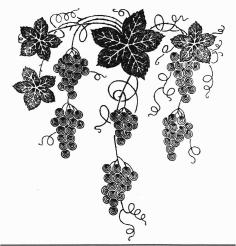 Martha, the second in our trio, is shown in Welkers Book I of
Cambridge catalog reprints (and in the drawing at left). These
illustrations are on pages from a
catalog bearing the "Near Cut" trademark (circa 1922) and on pages that
appear to date from 1928 or 1929.
Martha, the second in our trio, is shown in Welkers Book I of
Cambridge catalog reprints (and in the drawing at left). These
illustrations are on pages from a
catalog bearing the "Near Cut" trademark (circa 1922) and on pages that
appear to date from 1928 or 1929.
Martha also appears, to a very limited extent, in the NCC 1930-34 Catalog Reprint.
For your information, we are reprinting a page from the Near Cut era catalog, showing many of the items produced with the Martha etching. Also reprinted is a listing from an old price list, which indicates the pieces that were being produced with the Martha etch. This price list is for use with the Cambridge Glass Company catalog No. 10, dating to circa 1922. Sometime during the 1920s, Martha was also etched onto the #7606 stem line.
The later catalog pages reprinted by the Welkers show this etching on another jug, the #956 and on the #787 9½" vase. The sole reference to the Martha etching found in the NCC 1930-34 Catalog Reprint (page 50) shows the #797 8" vase.
In the November 1976 issue of the CRYSTAL BALL, a January 1933 advertisement showing a grape etching on the Tally Ho #1402/38 decanter was reprinted. This has been identified as Martha, but I feel it is more likely the Catawba etching, another of the "most confusing" Cambridge grape etchings. However, the picture is not really distinct enough to make a definitive statement as to the identity of the etching.
Martha does not appear in the Cambridge Glass Company catalog dated January 1940 or subsequent catalog additions and price lists. The most likely date for the discontinuance of this etching is sometime in the early 1930s, and it would appear that toward the end, very limited use was made of Martha.
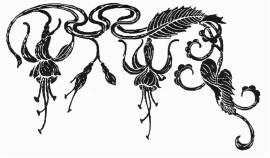 Marjorie (at left), the final member of the "3Ms", is by no means the least
significant member of our group. In its time, Marjorie was undoubtedly
a very important plate etching for a young and growing Cambridge Glass
Company. Unfortunately, very little has as yet been learned about
Marjorie, or for that matter, many of the early etchings.
Marjorie (at left), the final member of the "3Ms", is by no means the least
significant member of our group. In its time, Marjorie was undoubtedly
a very important plate etching for a young and growing Cambridge Glass
Company. Unfortunately, very little has as yet been learned about
Marjorie, or for that matter, many of the early etchings.
One must remember when discussing Marjorie, to distinguish between the plate etching and the pressed Near Cut pattern of the same name. Our subject here is, of course, the etching.
The only definite date established as to when Marjorie was first produced is May 1922. An advertisement from a trade publication of that date pictures the Marjorie etching on a goblet. A Near Cut era catalog, possibly dating to 1921, had at least three pages of Marjorie illustrations. Two of these pages were reprinted in the June 1978 issue of the CRYSTAL BALL, and the third page was reprinted by the Welkers in their Book I of Cambridge catalog reprints.
In the NCC 1930-34 Catalog reprint (page 33-19) the #1307 Candelabrum and the #1349 12" bowl are both shown with an etching stated as being E/764. This etching appears to be very similar, if not identical, to Marjorie. If this is in fact Marjorie, this is the only reference we have found for this etching, dating after 1930.
Marjorie was etched onto two very similar stemware lines: #7606 and #3223. They are so similar, the average collector will have difficulty in identification unless they are seen side by side, and the person is aware of the two lines. Both have similar bowl shapes and pulled stems. However, the diameter of the #3223 stem is slightly larger and shorter than the #7606 used on a bowl of identical capacity. The bowls themselves appear to be so identical, or nearly so, that any difference cannot be ascertained from a catalog page illustration.
Rather than go into a lengthy description of the items produced with the Marjorie etching, accompanying this article is a reprint of the listing for this pattern in the price list for the Cambridge Glass Company catalog No. 10, dating circa 1922.
Marjorie may have evolved from an early etching, known thru an advertisement in the February 1, 1915 issue of China, Glass & Lamps. This ad was reprinted in the June 1975 issue of the CRYSTAL BALL, and shows an etching similar to Marjorie, but having less detail. While the reprint is indistinct, it appears the plates used to produce this etching could very well have been reworked into Marjorie, as the basic Marjorie design appears to be present in the older etching. It is also possible this earlier etching is in fact Marjorie and was gradually modified into the design now known.
While most Marjorie being found today is on crystal blanks, a few pieces are known on both light green and pink blanks. A couple of stemmed items are in the NCC Museum in the light green color, and a creamer and sugar in pink will be pictured in the NCC Color book when it is published. Undoubtedly, additional pieces will be found and reported.
While not found in abundance today, a sufficient quantity of Marjorie etched pieces, primarily stemware, do appear to indicate a somewhat extensive production during the early to mid 1920s. Either that, or those who purchased Marjorie treasured it dearly, took extremely good care of their crystal, and passed their sets on to later generations. I say this since I have seen more Marjorie than the Minerva, which was introduced some twelve to fifteen years later. Of the three etchings discussed here, Martha is the least frequently seen pattern.
